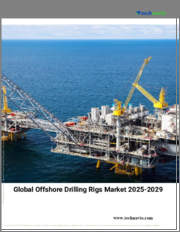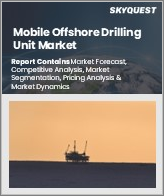
|
시장보고서
상품코드
1673776
해양 시추 시장 규모, 점유율, 성장 분석, 리그 유형별, 수심별, 지역별 - 산업 예측(2025-2032년)Offshore Drilling Market Size, Share, and Growth Analysis, By Rig Type (Drillships, Semisubmersibles), By Water Depth (Shallow Water, Deepwater), By Region - Industry Forecast 2025-2032 |
||||||
해양 시추 시장 규모는 2023년 384억 달러로 평가되었고, 예측 기간(2025-2032년) 동안 8.1%의 연평균 복합 성장률(CAGR)로 2024년 415억 1,000만 달러에서 2032년에는 774억 달러로 성장할 것으로 예측됩니다.
세계 해양 시추 시장은 기술 발전과 석유 및 천연가스 수요 증가로 인해 상승세를 보이고 있습니다. 심해에서의 채굴 프로세스가 자동화되면서 탐사 및 생산 활동에 대한 투자가 급증하면서 해양 시추가 점점 더 매력적으로 변하고 있습니다. 특히 멕시코의 석유 및 가스 부문 자유화와 심해 시추에 대한 관심이 높아지면서 시장 기회가 더욱 확대되고 있습니다. 북극권에서의 매장량 발견과 초심해 시추로의 전환도 주목할 만한 발전입니다. 그러나 높은 자본금 요건, 불안정한 유가, 엄격한 규제 등의 문제는 성장을 저해하는 요인으로 작용할 수 있습니다. 전반적으로 시장 상황은 최근 동향, 혁신, 시장 상황을 형성하는 중요한 요소들을 조명하고 있습니다.
목차
서론
- 조사 목적
- 조사 범위
- 정의
조사 방법
- 정보 조달
- 2차와 1차 데이터 방법
- 시장 규모 예측
- 시장 전제조건과 제한
주요 요약
- 세계 시장 전망
- 공급과 수요 동향 분석
- 부문별 기회 분석
시장 역학과 전망
- 시장 개요
- 시장 규모
- 시장 역학
- 성장 촉진요인과 기회
- 성장 억제요인과 과제
- Porter의 Five Forces 분석
주요 시장 인사이트
- 중요 성공 요인
- 경쟁 정도
- 주요 투자 기회
- 시장 생태계
- 시장의 매력 지수(2024년)
- PESTEL 분석
- 거시경제 지표
- 밸류체인 분석
- 가격 분석
- 규제 상황
- 사례 연구
- 기술 진보
해양 시추 시장 규모 : 리그 유형별
- 시장 개요
- 시추선
- 반잠수형 잠수정
- 잭업
해양 시추 시장 규모 : 수심별
- 시장 개요
- 천해
- 심해
- 초심해
해양 시추 시장 규모
- 북미
- 미국
- 캐나다
- 유럽
- 독일
- 스페인
- 프랑스
- 영국
- 이탈리아
- 기타 유럽
- 아시아태평양
- 중국
- 인도
- 일본
- 한국
- 기타 아시아태평양
- 라틴아메리카
- 브라질
- 기타 라틴아메리카
- 중동 및 아프리카
- GCC 국가
- 남아프리카공화국
- 기타 중동 및 아프리카
경쟁 정보
- 주요 5개사 비교
- 주요 기업의 시장 포지셔닝(2024년)
- 주요 시장 기업이 채택한 전략
- 최근 시장 동향
- 기업의 시장 점유율 분석(2024년)
- 주요 기업 개요
- 기업 상세
- 제품 포트폴리오 분석
- 기업 부문별 점유율 분석
- 매출 전년대비 비교(2022-2024년)
주요 기업 개요
- Schlumberger(USA)
- Transocean(Switzerland)
- Seadrill(Bermuda)
- Saipem(Italy)
- Perenco(United Kingdom)
- Noble Corporation(United Kingdom)
- Valaris Limited(Bermuda)
- Diamond Offshore Drilling(USA)
- Borr Drilling(Norway)
- Shelf Drilling(Dubai)
- KCA Deutag(United Kingdom)
- Maersk Drilling(Denmark)
- COSL Drilling Europe(Norway)
- Pacific Drilling(Luxembourg)
- Odfjell Drilling(Norway)
- Stena Drilling(Sweden)
- Aban Offshore(India)
- Japan Drilling Company(Japan)
- Vantage Drilling International(Cayman Islands)
- Saipem(Italy)
결론과 제안
LSH 25.04.23Offshore Drilling Market size was valued at USD 38.4 billion in 2023 and is poised to grow from USD 41.51 billion in 2024 to USD 77.4 billion by 2032, growing at a CAGR of 8.1% during the forecast period (2025-2032).
The global offshore drilling market is on an upward trajectory, driven by technological advancements and heightened demand for oil and natural gas. With automated extraction processes taking place in deep-water locations, offshore drilling is becoming increasingly attractive as investments in exploration and production activities surge. Notably, the liberalization of the Mexican oil and gas sector and a growing emphasis on deep-water drilling further propel market opportunities. The discovery of reserves in the Arctic and a shift to ultra-deep-water drilling are also noteworthy developments. However, challenges such as high capital requirements, volatile oil prices, and stringent regulations may impede growth. Overall, the market insights shed light on recent trends, innovations, and critical factors shaping the offshore drilling landscape.
Top-down and bottom-up approaches were used to estimate and validate the size of the Offshore Drilling market and to estimate the size of various other dependent submarkets. The research methodology used to estimate the market size includes the following details: The key players in the market were identified through secondary research, and their market shares in the respective regions were determined through primary and secondary research. This entire procedure includes the study of the annual and financial reports of the top market players and extensive interviews for key insights from industry leaders such as CEOs, VPs, directors, and marketing executives. All percentage shares split, and breakdowns were determined using secondary sources and verified through Primary sources. All possible parameters that affect the markets covered in this research study have been accounted for, viewed in extensive detail, verified through primary research, and analyzed to get the final quantitative and qualitative data.
Offshore Drilling Market Segments Analysis
Global Offshore Drilling Market is segmented by Rig Type, Water Depth and region. Based on Rig Type, the market is segmented into Drillships, Semisubmersibles and Jackups. Based on Water Depth, the market is segmented into Shallow Water, Deepwater and Ultra-deepwater. Based on region, the market is segmented into North America, Europe, Asia Pacific, Latin America and Middle East & Africa.
Driver of the Offshore Drilling Market
With around 4.4 billion people, or 56% of the global population, currently living in urban environments, the trend towards urbanization is set to continue, with projections suggesting that by 2050, about 70% of the global populace will reside in cities. This demographic shift is expected to fuel a substantial increase in energy demand, as urban areas typically have much higher energy needs than rural counterparts due to enhanced living standards and more intensive energy consumption patterns among city dwellers. As a result, the offshore drilling market is poised for significant growth to satisfy the rising energy demands of these expanding metropolitan populations.
Restraints in the Offshore Drilling Market
The Offshore Drilling market faces significant challenges due to the increasing operational costs that industry participants must manage. These escalating expenses stem from multiple components, including exploration, extraction, transportation, and maintenance operations. As these costs rise, they create a financial burden for companies, impacting their profitability and competitiveness in the market. This trend underscores the necessity for firms to adopt more efficient practices and technologies to mitigate these costs, thus ensuring sustainability and growth amidst the financial pressures that characterize the offshore drilling industry. Without addressing these rising expenses, companies may struggle to thrive and innovate in an increasingly competitive landscape.
Market Trends of the Offshore Drilling Market
The offshore drilling market is witnessing a significant trend towards deepwater and ultra-deepwater drilling, fueled by the depletion of onshore and shallow-water hydrocarbon reserves. As energy companies seek to maintain production levels, advancements in drilling technology and enhanced exploration techniques have enabled the viable extraction of resources from increasingly challenging environments. This strategic pivot is further supported by the discovery of new reserves, making deepwater fields increasingly attractive for investment. Consequently, the industry is likely to see intensified competition and innovation as companies strive to optimize operations, lower costs, and ensure sustainability in these complex drilling landscapes.
Table of Contents
Introduction
- Objectives of the Study
- Scope of the Report
- Definitions
Research Methodology
- Information Procurement
- Secondary & Primary Data Methods
- Market Size Estimation
- Market Assumptions & Limitations
Executive Summary
- Global Market Outlook
- Supply & Demand Trend Analysis
- Segmental Opportunity Analysis
Market Dynamics & Outlook
- Market Overview
- Market Size
- Market Dynamics
- Drivers & Opportunities
- Restraints & Challenges
- Porters Analysis
- Competitive rivalry
- Threat of substitute
- Bargaining power of buyers
- Threat of new entrants
- Bargaining power of suppliers
Key Market Insights
- Key Success Factors
- Degree of Competition
- Top Investment Pockets
- Market Ecosystem
- Market Attractiveness Index, 2024
- PESTEL Analysis
- Macro-Economic Indicators
- Value Chain Analysis
- Pricing Analysis
- Regulatory Landscape
- Case Studies
- Technological Advancement
Global Offshore Drilling Market Size by Rig Type & CAGR (2025-2032)
- Market Overview
- Drillships
- Semisubmersibles
- Jackups
Global Offshore Drilling Market Size by Water Depth & CAGR (2025-2032)
- Market Overview
- Shallow Water
- Deepwater
- Ultra-deepwater
Global Offshore Drilling Market Size & CAGR (2025-2032)
- North America (Rig Type, Water Depth)
- US
- Canada
- Europe (Rig Type, Water Depth)
- Germany
- Spain
- France
- UK
- Italy
- Rest of Europe
- Asia Pacific (Rig Type, Water Depth)
- China
- India
- Japan
- South Korea
- Rest of Asia-Pacific
- Latin America (Rig Type, Water Depth)
- Brazil
- Rest of Latin America
- Middle East & Africa (Rig Type, Water Depth)
- GCC Countries
- South Africa
- Rest of Middle East & Africa
Competitive Intelligence
- Top 5 Player Comparison
- Market Positioning of Key Players, 2024
- Strategies Adopted by Key Market Players
- Recent Developments in the Market
- Company Market Share Analysis, 2024
- Company Profiles of All Key Players
- Company Details
- Product Portfolio Analysis
- Company's Segmental Share Analysis
- Revenue Y-O-Y Comparison (2022-2024)
Key Company Profiles
- Schlumberger (USA)
- Company Overview
- Business Segment Overview
- Financial Updates
- Key Developments
- Transocean (Switzerland)
- Company Overview
- Business Segment Overview
- Financial Updates
- Key Developments
- Seadrill (Bermuda)
- Company Overview
- Business Segment Overview
- Financial Updates
- Key Developments
- Saipem (Italy)
- Company Overview
- Business Segment Overview
- Financial Updates
- Key Developments
- Perenco (United Kingdom)
- Company Overview
- Business Segment Overview
- Financial Updates
- Key Developments
- Noble Corporation (United Kingdom)
- Company Overview
- Business Segment Overview
- Financial Updates
- Key Developments
- Valaris Limited (Bermuda)
- Company Overview
- Business Segment Overview
- Financial Updates
- Key Developments
- Diamond Offshore Drilling (USA)
- Company Overview
- Business Segment Overview
- Financial Updates
- Key Developments
- Borr Drilling (Norway)
- Company Overview
- Business Segment Overview
- Financial Updates
- Key Developments
- Shelf Drilling (Dubai)
- Company Overview
- Business Segment Overview
- Financial Updates
- Key Developments
- KCA Deutag (United Kingdom)
- Company Overview
- Business Segment Overview
- Financial Updates
- Key Developments
- Maersk Drilling (Denmark)
- Company Overview
- Business Segment Overview
- Financial Updates
- Key Developments
- COSL Drilling Europe (Norway)
- Company Overview
- Business Segment Overview
- Financial Updates
- Key Developments
- Pacific Drilling (Luxembourg)
- Company Overview
- Business Segment Overview
- Financial Updates
- Key Developments
- Odfjell Drilling (Norway)
- Company Overview
- Business Segment Overview
- Financial Updates
- Key Developments
- Stena Drilling (Sweden)
- Company Overview
- Business Segment Overview
- Financial Updates
- Key Developments
- Aban Offshore (India)
- Company Overview
- Business Segment Overview
- Financial Updates
- Key Developments
- Japan Drilling Company (Japan)
- Company Overview
- Business Segment Overview
- Financial Updates
- Key Developments
- Vantage Drilling International (Cayman Islands)
- Company Overview
- Business Segment Overview
- Financial Updates
- Key Developments
- Saipem (Italy)
- Company Overview
- Business Segment Overview
- Financial Updates
- Key Developments




















